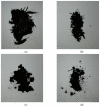UV-Assisted 3D Printing of Polymer Composites from Thermally and Mechanically Recycled Carbon Fibers
- PMID: 33673468
- PMCID: PMC7956419
- DOI: 10.3390/polym13050726
UV-Assisted 3D Printing of Polymer Composites from Thermally and Mechanically Recycled Carbon Fibers
Abstract
Despite the growing global interest in 3D printed carbon fiber reinforced polymers, most of the applications are still limited to high-performance sectors due to the low effectiveness-cost ratio of virgin carbon fibers. However, the use of recycled carbon fibers in 3D printing is almost unexplored, especially for thermoset-based composites. This paper aims to demonstrate the feasibility of recycled carbon fibers 3D printing via UV-assisted direct ink writing. Pyrolyzed recycled carbon fibers with a sizing treatment were firstly shredded to be used as a reinforcement of a thermally and photo-curable acrylic resin. UV-differential scanning calorimetry analyses were then performed to define the material crosslinking of the 3D printable ink. Because of the poor UV reactivity of the resin loaded with carbon fibers, a rheology modifier was added to guarantee shape retention after 3D printing. Thanks to a customized 3D printer based on a commercial apparatus, a batch of specimens was successfully 3D printed. According to the tensile tests and Scanning Electron Microscopy analysis, the material shows good mechanical properties and the absence of layer marks related to the 3D printing. These results will, therefore, pave the way for the use of 3D printed recycled carbon fiber reinforced polymers in new fields of application.
Keywords: additive manufacturing; carbon fibers; crosslinking; mechanical testing; polymer-matrix composites (PMCs); recycling; resins; rheology.
Conflict of interest statement
The authors declare no conflict of interest.
Figures








References
-
- Goh G.D., Yap Y.L., Agarwala S., Yeong W.Y. Recent Progress in Additive Manufacturing of Fiber Reinforced Polymer Composite. Adv. Mater. Technol. 2018;4:1800271. doi: 10.1002/admt.201800271. - DOI
-
- Valino A.D., Dizon J.R.C., Espera A.H., Chen Q., Messman J., Advincula R.C. Advances in 3D printing of thermoplastic polymer composites and nanocomposites. Prog. Polym. Sci. 2019;98:101162. doi: 10.1016/j.progpolymsci.2019.101162. - DOI
-
- Wang X., Jiang M., Zhou Z., Gou J., Hui D. 3D printing of polymer matrix composites: A review and prospective. Compos. Part B Eng. 2017;110:442–458. doi: 10.1016/j.compositesb.2016.11.034. - DOI
Grants and funding
LinkOut - more resources
Full Text Sources
Other Literature Sources

